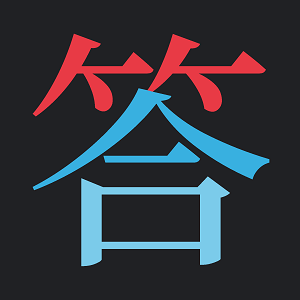答
부수: 竹
획수: 12획
答 has the meanings to answer and to reciprocate.

答 = 𥫗 + 合
X = semantic/phonetic borrowing + semantic/phonetic
• 𥫗 is a distortion of 艹 which depicts vegetation and is used to represent ‘beans’. Through a sound loan, it gets the meaning ‘to answer’ (the same meaning as 合).
• 合 depicts a mouth from above speaking downwards to a mouth below. This originally had the meaning ‘to answer’.
Evolution:
答 = a small bean ➔ borrowed use ➔ to answer ➔ to reciprocate
合 = 亼 + 口
• 亼 depicts a mouth speaking downwards from above.
• 口 depicts a mouth.
Mnemonic
See 合 as two mouths facing each other (one from the top-down and the other from the bottom-up). Imagine one mouth is asking a question and the other is answering.
Alternatively, understand that 合 can mean ‘join’ or ‘fit together’. Imagine a hut built together 合 from bamboo shoots with a thatched roof on top 𥫗.
Vocab
| 對하다 | 대하다 | to answer; to reply |
| 對答 | 대답 | answer; reply |
| 答辯 | 답변 | answer; reply |
| 答狀 | 답장 | written reply |
| 答信 | 답신 | reply; answer |
| 答辭 | 답사 | acceptance speech |
| 正答 | 정답 | correct answer |
| 誤答 | 오답 | incorrect answer |
| 問答 | 문답 | question and answer |
| 口答 | 구답 | verbal answer |
| 確答 | 확답 | definite answer |
| 應答 | 응답 | response; answer |
| 解答 | 해답 | answer; solution |
| 回答 | 회답 | formal reply |
| 答案紙 | 답안지 | answer sheet; answer paper |
| 報答 | 보답 | requital |
| 答禮品 | 답례품 | gift given in return |
Other resources
Image searches
Google
Bing
Yahoo Japan
Baidu (click 图片)
Sogou
Pinterest
Flickr
CJKV
CJKV Dict
Wikitionary
Unihan Database
Korean
Chinese
Written Chinese
Arch Chinese
ZDic
CC-Canto
Chinese Text Project
The Chinese University of Hong Kong (etymology)
Chinese Boost
Japanese
Takoboto
Jisho
JLearn.net
Sakura
The Kanji Map
Sentence Search
Immersion Kit
Vietnamese
Bibliography
Affiliate links help support uK.
— Daum 사전, [s.v. 答].
— Grant, B.K. (1982). A Guide To Korean Characters: Reading and Writing Hangul and Hanja, [s.v. 1153]. Seoul: Hollym.
— Outlier Dictionary of Chinese Characters, [s.v. 答, 𥫗, 合, 亼, 口].
— Seely, C., Henshall, K.G., & Fan, J. (2016). The Complete Guide to Japanese Kanji: Remembering and Understanding the 2,136 Standard Japanese Characters, [s.v. 202]. Singapore: Tuttle Publishing.